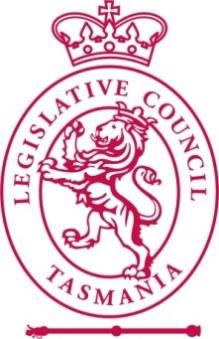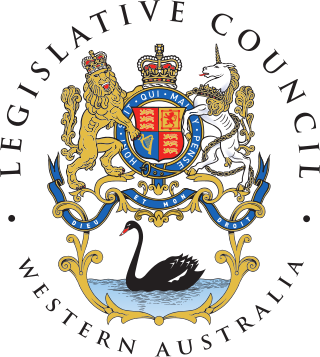Related Research Articles
Electoral systems of the Australian states and territories are broadly similar to the electoral system used in federal elections in Australia.

The Victorian Legislative Assembly is the state lower house of the bicameral Parliament of Victoria in Australia; the state upper house being the Victorian Legislative Council. Both houses sit at Parliament House in Spring Street, Melbourne. The main colour used for the upholstery and carpets furnishing the Chamber of the Legislative Assembly is green.

The Victorian Legislative Council (VLC) is the upper house of the bicameral Parliament of Victoria, Australia, the lower house being the Legislative Assembly. Both houses sit at Parliament House in Spring Street, Melbourne. The Legislative Council serves as a house of review, in a similar fashion to its federal counterpart, the Australian Senate. Although, it is possible for legislation to be first introduced in the Council, most bills receive their first hearing in the Legislative Assembly.

The Legislative Council, or upper house, is one of the two chambers of the Parliament of South Australia. Its central purpose is to act as a house of review for legislation passed through the lower house, the House of Assembly. It sits in Parliament House in the state capital, Adelaide.

The House of Assembly, or Lower House, is one of the two chambers of the Parliament of Tasmania in Australia. The other is the Legislative Council or Upper House. It sits in Parliament House in the state capital, Hobart.

The Tasmanian Legislative Council is the upper house of the Parliament of Tasmania in Australia. It is one of the two chambers of the Parliament, the other being the House of Assembly. Both houses sit in Parliament House in the state capital, Hobart. Members of the Legislative Council are often referred to as MLCs.

The Parliament of Victoria is the bicameral legislature of the Australian state of Victoria that follows a Westminster-derived parliamentary system. It consists of the King, represented by the governor of Victoria, the Legislative Assembly and the Legislative Council. It has a fused executive drawn from members of both chambers. The parliament meets at Parliament House in the state capital Melbourne. The current Parliament was elected on 26 November 2022, sworn in on 20 December 2022 and is the 60th parliament in Victoria.

The Parliament of South Australia is the bicameral legislature of the Australian state of South Australia. It consists of the 47-seat House of Assembly and the 22-seat Legislative Council. General elections are held every 4 years, with all of the lower house and half of the upper house filled at each election. It follows a Westminster system of parliamentary government with the executive branch required to both sit in parliament and hold the confidence of the House of Assembly. The parliament is based at Parliament House on North Terrace in the state capital of Adelaide.

The 1909 Alberta general election was the second general election held in the Province of Alberta, Canada. It took place on March 22, 1909, to elect 41 members to the 2nd Alberta Legislature. The incumbent Liberal Party led by Premier Alexander C. Rutherford achieved a re-election victory, securing a majority government by winning 36 out of the 41 seats in the legislature with just under 60 per cent of the popular vote. The Conservative Party led by Albert Robertson once again formed the official opposition, with only two members, and Robertson himself was defeated in his own seat in High River. The remaining three seats were divided among smaller parties and independent candidates.

The Western Australian Legislative Council is the upper house of the Parliament of Western Australia, a state of Australia. It is regarded as a house of review for legislation passed by the Legislative Assembly, the lower house. The two Houses of Parliament sit in Parliament House in the state capital, Perth.

Sir John Bowser, Australian politician, was the 26th Premier of Victoria. He was born in London, the son of an army officer, and arrived in Melbourne as a child with his family. He grew up at Bacchus Marsh and when he left school got a job with the Bacchus Marsh Express. As a young man he went to Scotland and worked on newspapers while studying at University of Edinburgh. Returning to Australia, he settled in Wangaratta, where he farmed and managed the Wangaratta Chronicle, which he eventually bought.

The 2002 Victorian state election, held on Saturday, 30 November 2002, was for the 55th Parliament of Victoria. It was held to elect the 88 members of Victorian Legislative Assembly and 22 members of the 44-member Legislative Council.

The electoral district of Melbourne is an electorate of the Victorian Legislative Assembly. It currently includes the localities of Docklands, Carlton, Melbourne, East Melbourne, West Melbourne, North Melbourne, Parkville, Newmarket, Kensington and Flemington, and includes Melbourne University. The district has been in existence since 1856.
In politics, a casual vacancy is a situation in which a seat in a deliberative assembly becomes vacant during that assembly's term. Casual vacancies may arise through the death, resignation or disqualification of the sitting member, or for other reasons.
The Electoral district of Public Officers was an electoral district of the Victorian Legislative Assembly. The 1903 Constitution Act reserved one seat in the Legislative Assembly to be elected by and from Public Officers and similarly two seats for Railway Officers, and one seat in the Legislative Council for both groups combined. In 1907, these four seats were abolished and such officers voted instead in their electoral district and province and were otherwise prohibited from political campaigning.
The Public and Railway Officers seat was an electorate of the Victorian Legislative Council. The 1903 Constitution Act reserved one seat in the Legislative Assembly to be elected by and from Public Officers and similarly two seats for Railway Officers, and one seat in the Legislative Council for both groups combined. In 1907, these four seats were abolished and such officers voted instead in their electoral district and province and were otherwise prohibited from political campaigning.

Members of the Victorian Legislative Council, the upper house of the Parliament of the Australian State of Victoria, are elected from eight multi-member electorates called regions. The Legislative Council has 40 members, five from each of the eight regions.

William Dartnell Johnson was an Australian politician who was prominent in state politics in Western Australia for most of the first half of the 20th century. A member of the Labor Party, he served in the Legislative Assembly on three occasions – from 1901 to 1905, then again from 1906 to 1917, and finally from 1924 until his death. Johnson was elected leader of the Labor Party in October 1905, but three weeks later lost his own seat at the 1905 state election. He had previously been a minister in the government of Henry Daglish, and later returned to the ministry under John Scaddan. Towards the end of his career, Johnson also served just under a year as Speaker of the Legislative Assembly, from 1938 to 1939.
This is a list of members of the Victorian Legislative Council at the election of 1 June 1904, up to the election of 4 June 1907. As half of the Legislative Council's terms expired at each triennial election, half of these members were elected at the 1902 election with terms expiring in 1907, while the other half were elected at the 1904 triennial election with terms expiring in 1910.

The 1904 Victorian state election was held in the Australian state of Victoria on 1 June 1904 to elect 67 members to the state's Legislative Assembly.
References
- ↑ "Re-Member (Former Members)". State Government of Victoria. Retrieved 23 May 2014.
- ↑
- Plehwe, R. (September 1983). "Political Rights of Victorian Public Employees". Australian Journal of Public Administration. 42 (3): 362–375. doi:10.1111/j.1467-8500.1983.tb00974.x.
- Constitution Act 1903 (No. 1864.)
- Constitution Act 1906 (No. 2075)